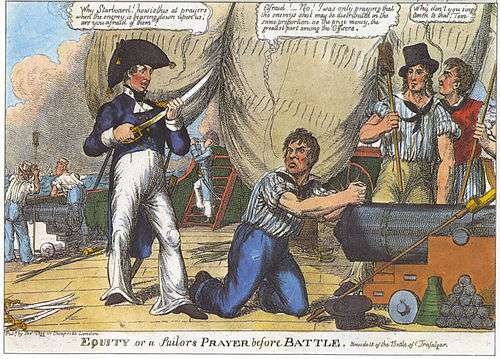Naval rating

A naval rating is an enlisted member of a country's navy, subordinate to warrant officers and officers hence not conferred by commission or warrant. The naval term comes from the general nautical usage of rating - a seaman's class or grade as recorded in the ship's books,[1] whilst in the United States it is currently used to denote a sailor's occupational specialty.[2]
The system of conferring authority on sailors in the Royal Navy and elsewhere evolved through the recognition of competence; Landsman, Ordinary seaman or Able seaman and through the appointment of authority as a petty officer.
Historically the term rate also applied to ships, denoting their combat strength by the number, and type, of guns.
The general structure now used in the majority of countries breaks down into four major groupings:
Royal Navy
United States Navy and United States Coast Guard
Rate refers to an enlisted sailor's position within the chain of command, as well as his or her pay grade. It is analogous to the term rank as used, for example, in the U.S. Army. However, the term "rank" should not be used in lieu of rate when referring to U.S. naval enlisted personnel.
A "rating" refers to the sailor's occupational specialty, combined with their paygrade (For example, a Fire Controlman in the paygrade E-5 would have the rate of FC2, or Fire Controlman Second Class). Navy personnel in pay grades E-1 to E-3 may not have a rate and are broadly classed into one of five groups, Seaman (SN), Fireman (FN), Airman (AN), Hospitalman (HN) and Constructionman (CN).
Petty Officers (E-4 to E-6) and Chief Petty Officers (E-7 to E-9) are sometimes referred to by a combination of rate and rating. For example, a Petty Officer Second Class with the rating of Gunner's Mate may be addressed as "Gunner's Mate Second Class" (abbreviated "GM2"). Similarly, a Chief Petty Officer with the rating of Quartermaster is referred to in formal occasions as "Chief Quartermaster" (abbreviated "QMC"). On less formal occasions, however, senior enlisted personnel are referred to simply as Chief, Senior Chief, or Master Chief, as applicable. Rate badges[3] consist of insignia (symbols) that indicate the sailor's rate[4] and rating.[5]
Within these a number of further specializations are available such as aviation electrician, or gas systems technician dealing with propulsion.[6]
See also
Notes
- ↑ New English Dictionary, p. 886
- ↑ "Enlisted Rating Insignia". America's Navy (navy.mil). United States Navy. Retrieved 6 June 2013.
- ↑ "U.S. Navy Officer Ranks and Enlisted Rates". America's Navy (navy.mil). United States Navy. Retrieved 6 June 2013.
- ↑ "RATE INSIGNIA OF NAVY ENLISTED PERSONNEL". America's Navy (navy.mil). United States Navy. Retrieved 6 June 2013.
- ↑ "ENLISTED RATING INSIGNIA". America's Navy (navy.mil). United States Navy. Retrieved 6 June 2013.
- ↑ Cutler, Thomas J., The Blue Jacket's Manual Centennial Edition, Naval Institute Press, Annapolis, Maryland, 2002, pg. 36–46
References
- Baker, Ernest A., The New English Dictionary, Odhams Press, London, 1932.
- Cutler, Thomas J., The Blue Jacket's Manual Centennial Edition, Naval Institute Press, Annapolis, Maryland, 2002. ISBN 9781557502087